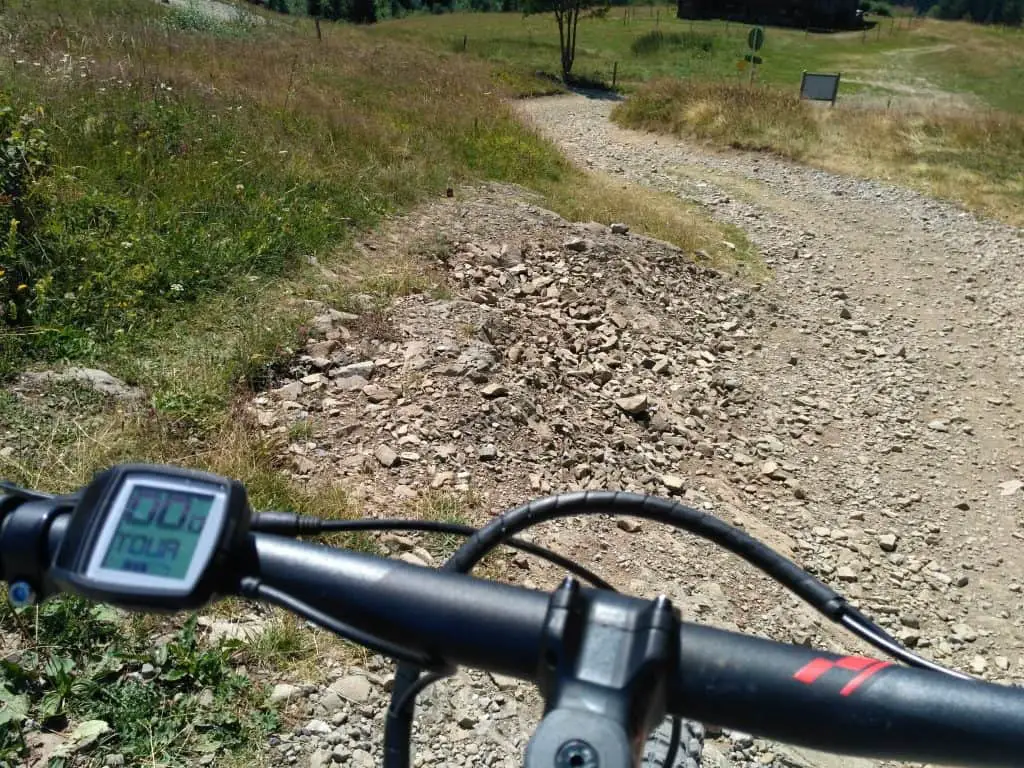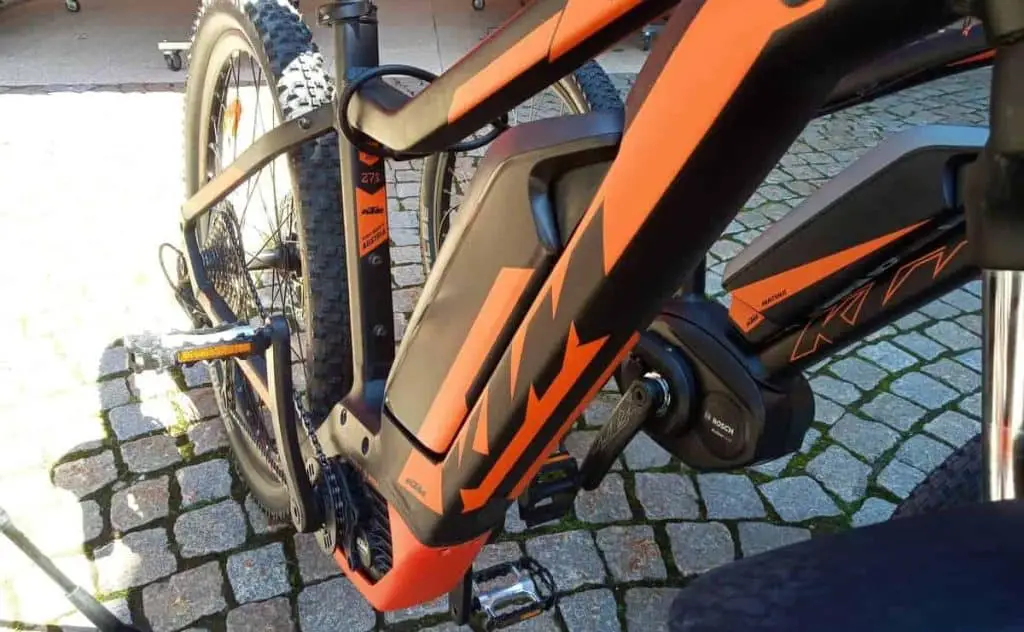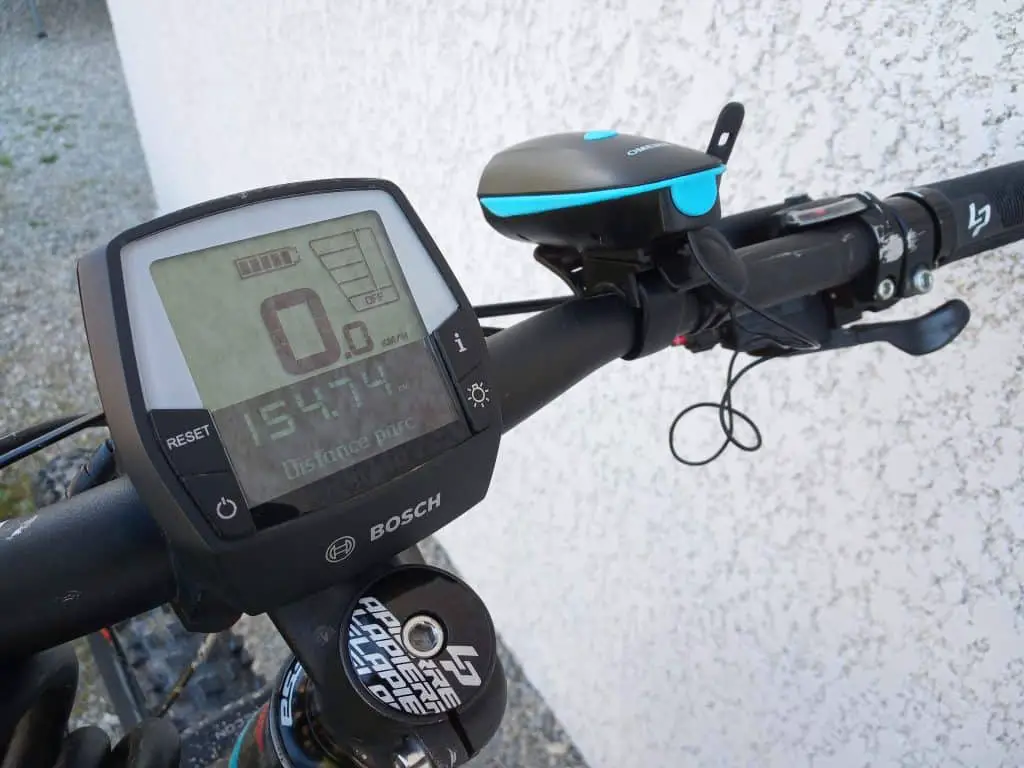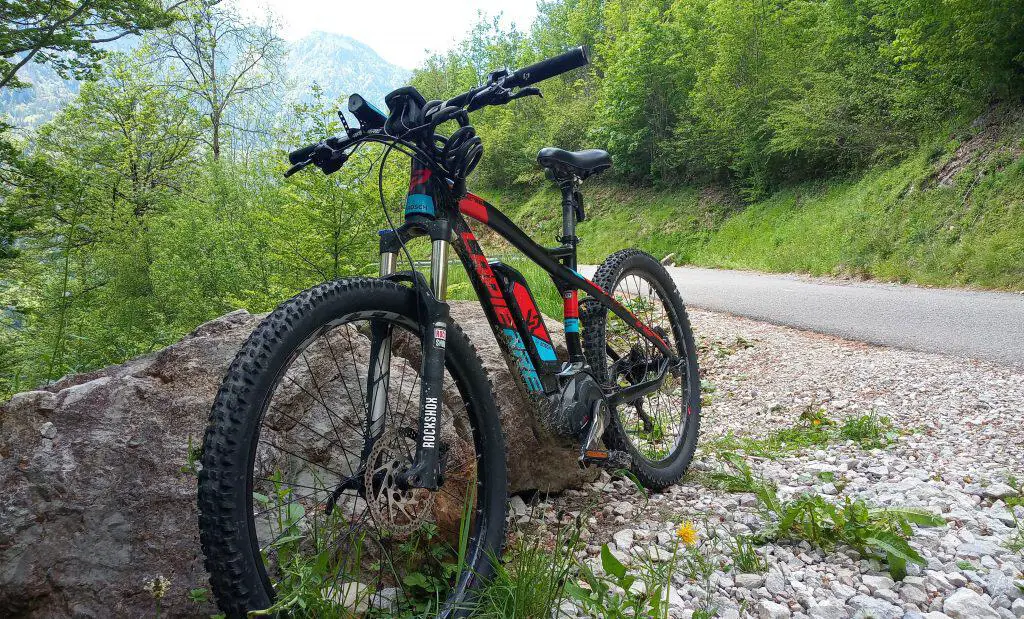Last Updated on November 12, 2021 by Igor Karni

How to choose an electric bike for cross-country trips? What if you plan to ride your electric bicycle in a city, and occasionally would not mind hitting some unpaved roads? What to pay attention to when selecting a cross-country or gravel electric bike?
Would a city e-bike model work for cross-country rides? What if you would like to commute to work on an e-bike could you also take it cross-country? Those are some of the questions you may be asking yourself if you are thinking about a road-ready / cross-country e-bike.
Read also: How to select the best city e-bike (with examples)? – also in this article, and this article. And, How much does a good city e-bike cost?
How to choose an electric bike for cross country roads? Pay attention to longer riding range and thus, more battery capacity and motor power. You will also need more speed options, wider tires, and larger wheels, which will help to attack various terrain. A comfortable seat and a one-piece frame are a necessity.
Let’s take a closer look at what one needs to consider when selecting an electric bike for cross-country trips.
Read also: How to select the best commuter e-bike (with examples)? – also in this article. And, how much does a commuter e-bike cost?
Let’s dive right in.
Choosing a touring electric bike
Easy tip: There are e-bike models, specifically designed for cross-country or road rides.
Buying an e-bike for going cross-roads – both city and off-pavement routes – would demand a somewhat different decision process as compared to choosing an e-bike for city trips or for regular commutes.
You will be riding longer. Going on a cross-country trip, you are likely to be spending more time on your e-bike than either on a brisk city ride or on a daily commute.
There will be not as many stops and not as many sharp turns. If you are not in the mountains, you are likely to be mostly taking long straight roads during your rides. You will not encounter that many frequent stops on road lights or sharp turns on street corners to avoid pedestrians.
Some roads will be paved, others will be not. It is likely that on a cross-country ride your e-bike’s wheels will not always be touching smooth asphalt. Going off a beaten path is certainly part of the fun of going cross-country!
Keeping the above in mind, let’s see what should we look for in a road-ready e-bike to enjoy occasional trails and scenic and narrow country roads.

Longer battery life
As it is likely that you will be making a half-day or even day-long trip on your road electric bike, sufficient battery life is necessary. You will probably not have an option to recharge your battery on the trip, so one full charge should be able to take you around. Making a “my battery has died” call to a friend is the last resort and is likely to spoil your trip.
On a standard cross-country trip, a good battery should be able to take you 60 to 100 km (35 to 60 miles) without a recharge. Current e-bike road models claim an autonomy range of 80 km on the second level of electric assistance.
Read also: How to use gears on an electric bike (mechanic and electric)? And, How to switch electric assistance levels on an e-bike?
If you are going on a long road trip, you also need to consider taking an additional fully charged battery with you or planning a battery recharge stop. A full charge takes 4-6 hours, although e-bike batteries are gradually becoming more advanced and will be able to charge faster.
You can always pedal your electric bike home, without using electric power. This means that you should be able to get home in any case, even when the battery went flat. As electric bikes are usually heavier, pedaling without electric assistance will not be as easy as riding on electric power.
Read also: How heavy are e-bikes? And, Can an e-bike pool a trailer?
It helps to have a wider range of gears if you plan to occasionally ride your bike as a conventional bike, without electric assistance.
Battery range is defined by the landscape and electric assistance level used
Most e-bike speed and distance monitors (usually mounted on the handlebar) show, how much battery capacity is left. Often this indication is shown as bars, just like one would see on a smartphone screen. It can also be shown in percentages or both.

Unfortunately, such indications may be misleading as they do not precisely show how much battery capacity is left. Are we at the beginning of the fourth bar or at the end of it? Hard to tell. So treat this indication as an estimate only.
Many e-bike speed monitors also show the estimated remaining riding range. The estimated remaining riding range is a more accurate measure. Just like in a car, you see, how many kilometers (or miles) you will be able to ride till you need to put more electric power (more fuel) in.
Easy tip: Estimated remaining riding range depends on the electric power assistance level you are using.
Use the following table as an estimate. Distances may vary, depending on the landscape, the e-bike model used, weather conditions, and also the age of your e-bike battery.
| E-assistance level | Est. distance, km | Est. distance, miles |
| Eco, level 1 | 100 km | 62 miles |
| Normal, level 2 | 60 km | 37 miles |
| Power, level 3 | 35 km | 22 miles |
As you go through several long trips on your e-bike, you will be able to better judge the distance your battery can take you. To save battery, it makes sense to completely turn off electric assistance, when going downhill, and to use lower levels of assistance when riding on flat or nearly flat roads.
This tactic will make you pedal a bit more, but it will save battery power and will help make you a bit healthier as well.
Powerful motor
On cross-country trips, the landscape will most certainly vary – from flat valleys to steep hills. To cope with this variability you need to be looking for a motor that is relatively more powerful than for city trips or commutes to work.
Read also: Can e-bikes help go up steep hills? And, How to switch electric assistance levels on an e-bike?
A standard 24V / 10 amps / 250W e-bike motor and battery could do a good job in the city, but will not have sufficient power for steep hills, especially if you are above 70-80 kilos (155 – 175 lbs).
As general guidance, consider starting with a 36V / 15 amps / 500W e-bike as your preferred option for county road trips.
Large wheels and wider tires
For comfortable rides on cross-country narrow roads and trails, you will need larger wheels and thicker tires. Larger wheels will give you more distance for each pedal move, while thicker tires will help with additional stability on the ride.
Depending on your own height, I recommend having a 26-29” tire size for a cross-country e-bike. At this tire size, you will sit high above the road to enjoy the scenery. Moreover, you will get the maximum distance for your pedaling efforts.
Try taking a 24” foldable city bike for a long ride in the countryside and you will very quickly realize its limitations.
Thicker tires are also a must-have for cross-country. Thicker tires add stability to the ride and help not so much sense obstacles on the road, such as road bumps or stones. For improved stability, it is a good idea to use tires with cross-country tire tread.

More speed options to attack various terrain
Most e-bike models will have three or four electric assistance modes, ranging from OFF (or no assistance) to TURBO (maximum assistance) mode. This range is generally enough to support you on your cross-country trips.
What may make a difference, is the number of mechanical speeds that complement electric assistance. Similar to a conventional, say a 21-speed bicycle, an electric bike should also have a number of mechanical speeds for each of its electric modes.
Read also: How to use gears on an electric bike (mechanic and electric)? And, How to switch electric assistance levels on an e-bike?
A 21-speed model means that there are three electric speed modes on the left handle of the handlebar. There are seven mechanical speed modes on the right handle of the handlebar. This gives 21 speed combinations in total.
An electric bike, for each of its electric assistance modes, should also have seven or eight mechanical speeds. Once you master these combinations, this skill will help you have a smoother and more pleasant ride and will help save battery power.
One-piece non-foldable frame
I recommend a one-piece non-foldable frame e-bike for cross-country road trips. Foldable electric bikes offer the necessary flexibility on commutes and while maneuvering in city traffic.
But, foldable e-bikes come in smaller sizes and this will not be optimal for out-of-the-city rides.
Consider a sporty sitting position
While I did not recommend a sporty sitting position for city electric bikes and even for commuter electric bikes, it makes better sense to consider a sporty sitting position for your cross-country endeavors.
A sporty sitting position is a matter of personal preference and may take some time to get used to. In my opinion, it limits viewing level and, if you are not used to it, may result in certain back pain after the first few rides.
On the other side, on longer and more complex cross-terrain rides, it will give you more control of the bike on the road. This position will also help you distribute more of your body weight to the handlebar and take it off your bottom. This can be helpful to reduce bottom pain.
A comfortable seat is essential
On a long cross-country ride, having a comfortable seat can make or break it (and it is related to the sore butt as well). You do not want to be standing on your bike while you pedal or take frequent stops, just because the seat is not comfortable and “you cannot sit any longer”.
Spend some time trying different seat forms. Seats are usually easily replaceable. One compromise would be to buy a seat cushion cover. Cushion covers are not recommended for longer trips though as they tend to shift and cause skin irritation.
Packing rack or backpack?
You are most likely to take water, snacks, an emergency repair kit, and a few other necessary things with you on a cross-country trip.
Read also: What to take with you an an e-biking trip? And, Can an e-bike pull a trailer?
Having a rear rack installed will solve the problem of carrying additional luggage on your e-bike. Rear racks usually have standard connectors and depend on bike size. Make sure the model you are considering either already has a rear rack installed or has it as an option.
Carrying a backpack is also always an option. On a cross-country e-biking trip, you do not have to worry too much about potential sweat spots on your back, as you would do, for example, if you were commuting to work. So, if you like carrying a backpack (as I do), it will be your friend and companion on a trip.
Read also: How not to sweat on your e-bike commute? Trip planning – in this article, on the road – in this article, when you arrive – in this article.
Will my city e-bike be good for touring trips?
Generally speaking – no. City electric bicycles are usually designed for flat city streets. They tend to have fewer speed options, thinner wheels, flat tire treads, and less powerful motors.
Read also: Here is why e-bikes are really cool. And, How to select the best city e-bike (with examples)?
City electric bikes are good for brief city rides on smooth roads. Few minutes to go to a supermarket or take kids to school.
Although you can certainly take a city electric bike on a cross-country tour, you will quickly see limitations of city models for demands of cross country and cross terrain.
Can I use my commute e-bike for touring trips?
Generally – yes. You could possibly use a commute electric bike for taking on your favorite country roads. If your commuter model is not a foldable one and it is not of small size (wheels are 26″ and above).
It has a powerful motor, sufficient battery life, and enough speed combinations. You would be ready to try it on a cross-country trail.
Will my mountain e-bike be good for touring trips?
Generally also – yes. Mountain electric bikes are often the most well-designed and well-thought-through pieces of engineering. Riding in the mountains is certainly the most demanding. Mountain electric bikes have more sophisticated and longer-lasting batteries, more powerful motors, wheels, and tires, geared for rough terrain.

All-mountain electric bikes are designed for sporty leaning forward riding position though. If you are not comfortable with a sporty riding position, you will either have to get used to it or consider a different model for your trips.
Read also: How to select your first electric mountain bike? And, How much does a good eMTB e-bike cost?
Also, seats on mountain electric bikes are designed for performance, not necessarily for comfort. Mountain bikers often stand on their bikes, as they cross various obstacles or go fast downhill.
If you consider using a mountain bike for long country road trips, see if such a model suits you. Try and take it on a ride before you consider buying one.
Closing thoughts
Going on cross-country tours on a well-chosen electric bicycle should be a lot of fun. After all, why not? You are using the power of an electric motor to move you forward. You are getting healthier with every pedal stroke and you are seeing beautiful scenery all around.
Choose an e-bike with a more powerful motor and battery that will be sufficient for around 100km (62 miles). Learn to actively use gears to conserve battery power for longer. Do not forget larger wheels, thicker tires, and a comfortable seat. And you will be closer to your goal!
Remember that there is always an option to try! Ask your local e-bike dealer or rental agent to rent out a cross-country model that is close to what you consider buying. Spend a few hours testing it on the road, paying attention to the tips that we have discussed above.
This will certainly be time well spent. You will make a much better-educated decision when finally making a purchase.
Igor is a sustainable mobility and green energy advocate. His mission for Easy E-biking is to help make electric cycling simple, practical, and fun. Follow him on Facebook and LinkedIn.




